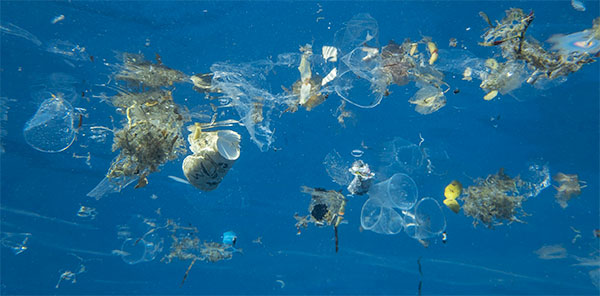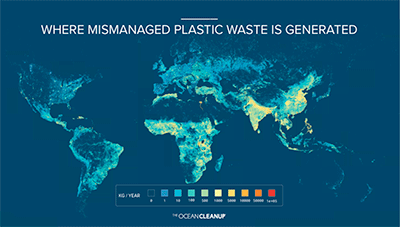Microplastic Removal: Street Sweeping's Newest Challenge? |
|
by Ranger Kidwell-Ross
The world has a plastic pollution crisis. Humans have produced more than 8 billion tons of plastic since 1950, more than half of which went straight to landfills. Only about 9% was recycled.
The Center for Biological Diversity calls the ocean plastics pollution problem "a global tragedy for our oceans and sea life. Plastic accumulating in our oceans and on our beaches has become a global crisis. Billions of pounds of plastic can be found in swirling convergences that make up about 40 percent of the world's ocean surfaces. At current rates plastic is expected to outweigh all the fish in the sea by 2050."

Perhaps not surprisingly, the U.S. produces the most plastic waste. According to data from 2016, the U.S. produced over 34 million tons, followed by India (26m/tons), and China (21.5 m/tons). However, when calculated as 'plastic waste per capita,' vastly different countries emerge: Micronesia is the leader at 680 lbs/person; Bermuda with 454 lbs/person; and, Palau with 375 lbs/person. In this latter category the U.S. is not in the top ten. Also, production of plastics is not the same as the polluting of them, in that recycling programs differ widely in different locations.

The above graphic is from a mid-2019 worldwide assessment of the riverine inputs of trash into the ocean. Anecdotally, the Greater Los Angeles region is seen to be somewhat of a west coast hot spot for land-based inputs into the coastal ocean. Over time, street sweeping studies have targeted a variety of other pollutants, including nutrients like phosphorus and nitrogen; heavy metals like lead, copper and zinc; and toxics like PAHs among others. Now, it appears that a new threat is emerging: microscopic-sized plastic waste in the urban environment. Because the most damage is done from the smaller particles of plastic, which are most easily ingested into the food chain, the term "microplastics" has come into widespread usage. These are defined as small plastic pieces less than five millimeters long, the size most harmful to ocean and aquatic life. That said, when allowed the larger plastic litter we often see lying on the ground get into waterways, gets run over by tires, degrades in the sun, or goes into our waterways when it rains and more easily becomes microplastic particles.
Some startling statistics:
What might be termed "the sixth microplastic" – or at least another substance that has become a major concern – are 'rubber crumbs.' These are the particles of rubber that are created as tires wear. Not surprisingly, the rubber contains chemicals that are harmful to salmon. As a result of these emerging findings, the State of California is proposing a requirement that tiremakers seek to use alternative chemicals designed to protect water quality. Why does this matter? Here's just one example of many:Normal fish development is largely regulated by their growth and thyroid hormones. These hormones are increasingly being affected by the biologically active chemicals, such as bisphenols, leaching from plastic waste. Bisphenol A (BPA), a component of many plastics, is one of the most abundantly produced industrial chemicals worldwide. This active chemical, among other plastic-derived pollutants, has become a serious concern in waterways and in other aspects of the environment. Ingestion by fish and other organisms can cause abrasions or internal blockages; the latter can lead to outright starvation. Plastics spread toxins across ecosystems. Aquatic organisms can even get defects as they absorb pollutants into their skin. A major problem with microplastics is they are often too small for wastewater treatment plants to filter out, meaning plastic can easily enter waterways from that source and end up in our drinking water. There's no question that much of this plastic waste pollution is coming from paved areas. That raises the question of what the most cost-effective way would be to best reduce the runoff of the plastic material, both larger used containers (plastic litter) and microplastic particles (under 5mm), into waterways.
How can sweeping mitigate urban microplastic runoff?Street sweeping has been found to be a significant – and for many pollutants the most cost-effective – way to remove quite a variety of toxic materials, including phosphorus, nitrogen and zinc. In addition, the exhaustive Florida study linked above found street sweeping to be the most effective way to remove overall street-based particulate matter (PM), with a calculated cost of $.11/pound. This compared to $.70/pound for the second-best method, catch basin cleaning.
The reason the above is important is that it would seem like sweeping's ability to pick up overall particulate matter would be the best determinant of the amount of plastic – both plastic litter and microplastic – that could be removed from the street in what is likely the most cost-effective manner: street sweeping.
The State of California adopted a requirement to implement a statewide microplastic strategy by 2021. This necessarily must include a commitment to address microplastic runoff from urban pavement. As a component of this expanding effort the State Water Board has committed to eliminating trash from stormwater discharge to the ocean but the science behind these regulations focus on the visible forms of plastic litter we see lying on the ground, larger than 5 mm, and not the microscopic scale particles that represent perhaps a greater level of concern.
A variety of plastic product bans have also been implemented by the state and/or various municipalities, like a ban on single-use plastic bags, on polystyrene (styrofoam) and more. California, like northern neighbor Oregon that introduced one in 1971 as the first in America, has implemented a recycling payment system. Consumers pay $0.05 for containers under 24 ounces and $0.10 for containers over 24 ounces.
Research by the San Francisco Estuary Institute and others has determined that urban stormwater and creek discharge is a major source of microplastic to San Francisco Bay.
Murray said "the City of Santa Barbara has collaborated with the University of California, Santa Barbara, to study the removal of microplastics by street sweeping. Their pilot project, funded by the UCSB Associated Students Coastal Fund, will provide information about microplastic contained in stormwater runoff, street dirt and street sweeper debris."
Dr. Murray and her colleagues hope to continue their research on microplastic and the effectiveness of street sweeping to remove microplastics from the environment in a cost-effective way.

"The real question will be how much of the overall plastic and microplastic discharges found in urban stormwater discharges will sweepers will be able to remove? That will largely depend upon the percentage of total microplastic discharge that comes from pavement that's available to be swept. "The specific gravity of the particulate fraction of "street dirt" is similar to that of sediment or around 2.6. So the good news in terms of potential pick-up by street sweepers is that these troublesome tire wear particles and other microplastics are much lighter, with a range of 1.2 to 2.0 and the mean around 1.6. "So, the sweeper is going to be very effective in removing them when encountered. Of course the greater challenge will be the size of the particles themselves. If we focused just on particle count and not mass the same behavior you have seen with tire particles exists with street dirt in that the number of particles is heavily skewed toward the smaller sizes. However, the regulation of the more conventional pollutants is based on mass or load as in Total Mass Daily Load (TMDL). And, in concentration, which is Mass/Volume of Water. "Another question related to that is: What portion of the plastic and microplastics loadings could be mobilized during a runoff event from areas the street sweeper either doesn't sweep or can't access? Much of those areas are usually due primarily to parked cars. As a result, it would seem that vehicle removal will become even more important than ever when microplastics are thrown into the 'removal equation.' Also, will there be a difference in pickup ability of the smaller particles between vacuum and regenerative air sweepers?"
In the event you have questions or comments about this article, please contact the author, Ranger Kidwell-Ross, via email sent to editor@
WorldSweeper.com.
To contact Roger Sutherland send an email to sutherland.roger1@gmail.com. To reach Jill Murray send an email to JMurray@SantaBarbaraCA.gov
Every month, WorldSweeper offers an award-winning free e-newsletter packed with a variety of information about the power sweeping industry. This includes links to studies and reports, among many other topics. If you do not currently receive the newsletter, use this signup link.
|
© 2005 - 2022 World Sweeper
|
Street Contents
|